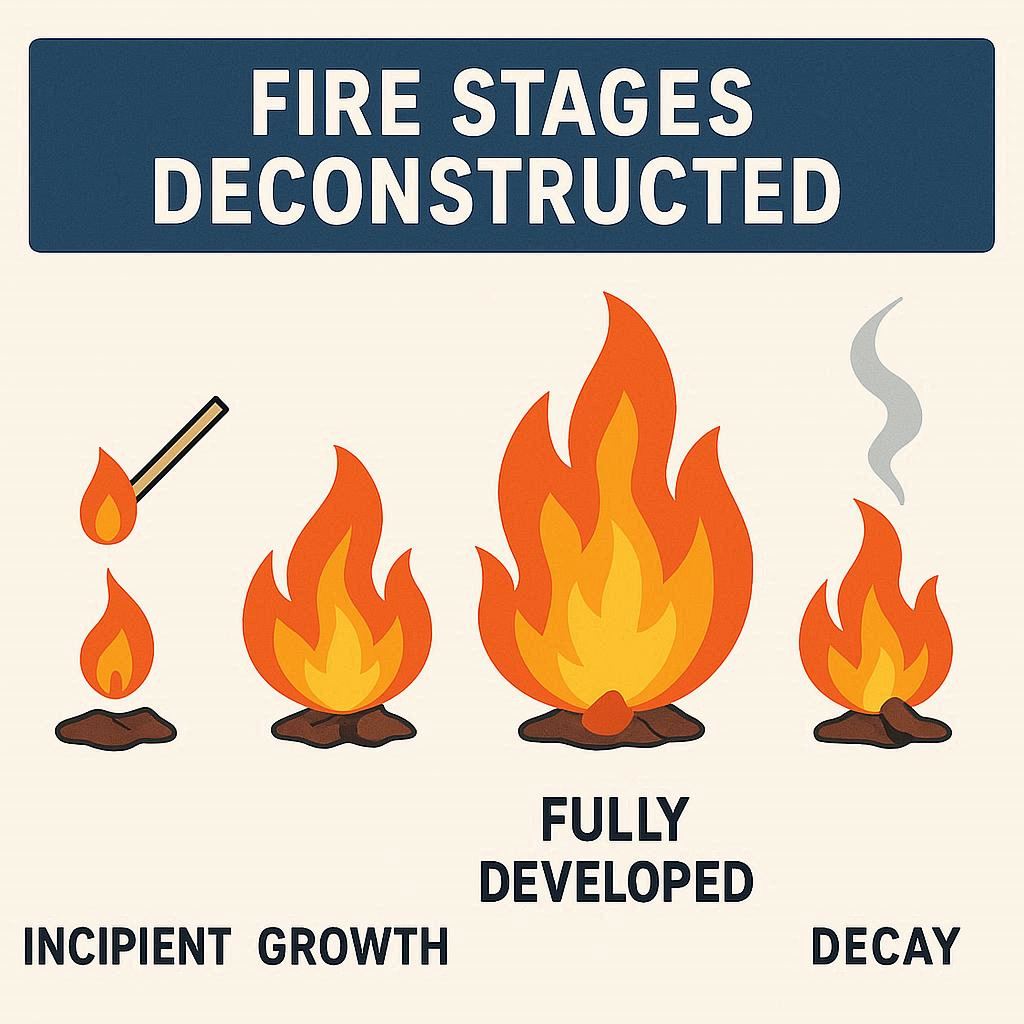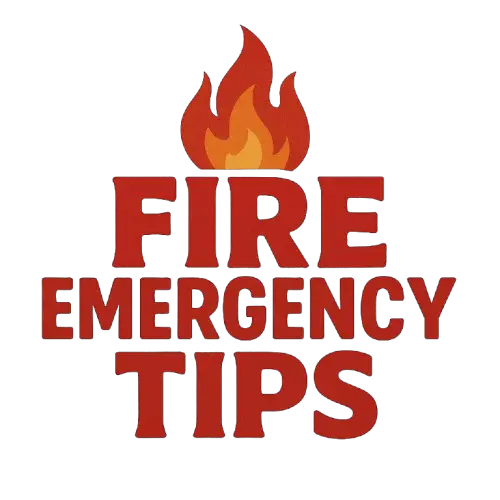
Understanding how a fire behaves isn’t just about watching flames dance — it’s about recognizing patterns, heat movement, oxygen flow, and material reactions. Every firefighter knows that fire has a life cycle, from its quiet ignition to its violent flashover and eventual burnout. Breaking down these stages of fire provides crucial insights for tactical response, safety, and rescue operations.
Let’s walk through each phase — from a firefighter’s perspective — and explore what’s happening, what to look for, and how to respond effectively.
🚪 1. Incipient Stage (Ignition Phase)
🔹 What Happens
The incipient stage begins the moment heat, fuel, and oxygen come together — the fire triangle. At this point, combustion is localized and controllable. The flame may be small, confined to a single object, or limited to smoldering material.
Common sources include:
- An unattended candle or match
- Faulty wiring or short circuits
- Spontaneous ignition (oily rags, hay, etc.)
- Static discharge in flammable vapors
🔹 Firefighter’s Insight
This is the most critical window for intervention. A portable extinguisher or quick water stream can often stop it before it grows. Smoke at this stage is light and pale gray, with minimal heat buildup.
Firefighter focus:
- Identify the fuel source early.
- Cut power and oxygen supply.
- Use the appropriate extinguisher type (Class A, B, C, etc.).
🔹 Key Indicator
👉 Small flames, faint smoke, and no significant heat spread yet.
🔥 2. Growth Stage (Development Phase)
🔹 What Happens
Now the fire has found ample oxygen and fuel, causing flames to spread rapidly. The room’s temperature increases dramatically as heat transfers by convection and radiation. Smoke thickens and darkens, forming hot gas layers near the ceiling.
As oxygen is consumed, the fire starts “breathing” — pulling in fresh air and pushing out heated gases. This is when conditions start turning dangerous.
🔹 Firefighter’s Insight
This is where tactical awareness is everything. Visibility drops, and structural integrity starts to weaken. The ceiling layer can reach hundreds of degrees, ready to ignite additional materials.
Firefighter focus:
- Check for signs of flashover (rolling flames, intense heat, rapidly darkening smoke).
- Begin ventilation carefully to control oxygen flow.
- Coordinate with the attack team — this is the make-or-break stage.
🔹 Key Indicator
👉 Rapid flame spread, thick smoke, and increasing heat intensity.
💥 3. Fully Developed Stage (Flashover Phase)
🔹 What Happens
This is the peak of the fire’s life cycle. Everything combustible in the area ignites nearly simultaneously — a phenomenon known as flashover. Temperatures can exceed 1,100°F (600°C).
At this stage:
- Flames engulf the entire room.
- Oxygen is rapidly consumed.
- The fire generates its own convection currents, pulling air from adjoining spaces.
🔹 Firefighter’s Insight
A fully developed fire is extremely dangerous. Structural elements begin failing, and survival chances for trapped victims drop dramatically. Firefighters rely on coordinated attack lines, ventilation, and thermal imaging to navigate safely.
Firefighter focus:
- Protect egress routes.
- Use high-flow nozzles and proper fog patterns to absorb heat.
- Avoid entering flashover-risk areas without cooling the gases first.
🔹 Key Indicator
👉 Flames everywhere, floor-to-ceiling fire, roaring sound, and unbearable heat.
🌫️ 4. Decay Stage (Smoldering or Burnout Phase)
🔹 What Happens
Eventually, the fire runs out of oxygen or fuel. Flames shrink, but hidden embers and smoldering materials remain. Even without visible flames, this stage is deceptively dangerous — toxic gases like carbon monoxide and hydrogen cyanide linger, and re-ignition can occur if air rushes back in.
🔹 Firefighter’s Insight
Firefighters must perform overhaul carefully to prevent rekindles. The decay phase often signals structural instability due to prolonged heat exposure.
Firefighter focus:
- Search for hot spots using thermal imaging cameras.
- Ensure complete extinguishment and proper ventilation.
- Monitor CO levels before declaring the scene safe.
🔹 Key Indicator
👉 Smoke remains, low oxygen, smoldering debris, weakened structure.
🔄 The Fire’s Life Cycle in Summary
| Stage | Primary Characteristics | Firefighter Focus |
|---|---|---|
| Incipient | Small flame, localized, minimal smoke | Quick extinguishment |
| Growth | Rapid flame spread, high heat, flashover risk | Ventilation, attack coordination |
| Fully Developed | Peak intensity, structure at risk | Suppression, safety, cooling gases |
| Decay | Dying flames, lingering smoke, hidden embers | Overhaul, prevent rekindle |
⚠️ Additional Phenomena Firefighters Watch For
1. Flashover
A sudden ignition of all combustible gases in an area. Temperatures spike instantly. Warning signs: rollover flames, rapidly darkening smoke, and heat felt even at floor level.
2. Backdraft
Occurs when oxygen suddenly enters a superheated, oxygen-depleted space. Results in an explosive fireball. Warning signs: pulsing smoke, blackened windows, whistling sounds.
3. Smoke Explosion
Combustible gases accumulate and ignite independently of the main fire. Can happen during or after the decay phase.
Firefighters train constantly to read smoke color, movement, and behavior, as these are often the earliest indicators of changing fire conditions.
🧯 Fire Behavior and Tactical Strategy
1. Ventilation Timing
Opening a roof or window at the wrong time can feed the fire. Tactical ventilation should coincide with water application to control oxygen balance.
2. Thermal Imaging
Modern firefighters rely on thermal cameras to read heat layers and locate hidden fires. This helps predict flashover potential and locate victims faster.
3. Flow Path Awareness
Understanding how air moves through a structure helps control fire growth. Closing doors and creating isolated compartments can slow fire spread dramatically.
4. Water Application Techniques
- Direct Attack: Water applied directly to the burning material.
- Indirect Attack: Water spray into hot gases to cool the environment before entry.
- Combination Attack: A balance of both, often used in enclosed structures.
🧠 Lessons from the Line: Firefighters’ Practical Insights
- Fire rarely behaves as expected. Each structure, material, and airflow condition changes how quickly stages evolve.
- Early recognition saves lives. Noticing small heat increases, smoke changes, or flame patterns early allows for a safer, more effective response.
- Never underestimate smoldering fires. Many rekindles and post-fire injuries occur during the decay phase due to hidden heat pockets.
- Continuous training in live burns and simulations sharpens instinct for real-world incidents.
❓ FAQs
Q1: How long does each stage of fire last?
It depends on the fuel and oxygen supply. The incipient stage may last seconds, while a fully developed fire can rage for several minutes before decaying.
Q2: What’s the difference between flashover and backdraft?
- Flashover: All contents ignite simultaneously due to high radiant heat.
- Backdraft: An explosion caused by sudden oxygen introduction into a smoldering fire.
Q3: Why do firefighters ventilate burning buildings?
To release superheated gases, improve visibility, and reduce flashover risk. Controlled ventilation directs heat and smoke away from firefighters and trapped occupants.
Q4: What are the signs of an impending flashover?
Thick, dark smoke, rolling flames across the ceiling, intense heat even at floor level, and “lazy” flames that suddenly become violent.
Q5: Can a fire skip stages?
Yes. In fuel-rich environments (like a car fire or warehouse), a blaze can jump from incipient to fully developed in seconds.
🔚 Final Thoughts
Every fire tells a story — from a small spark to a roaring inferno. For firefighters, reading that story in real time is what separates safe operations from tragedy. By understanding each stage of fire development, firefighters can predict behavior, plan effective attacks, and protect both their team and the public.
Mastering the science of fire isn’t about memorizing terms — it’s about anticipating danger before it happens and responding with skill, precision, and courage.
